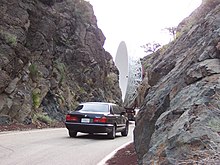
In telecommunications and radar, a Cassegrain antenna is a parabolic antenna in which the feed antenna is mounted at or behind the surface of the concave main parabolic reflector dish and is aimed at a smaller convex secondary reflector suspended in front of the primary reflector. The beam of radio waves from the feed illuminates the secondary reflector, which reflects it back to the main reflector dish, which reflects it forward again to form the desired beam. The Cassegrain design is widely used in parabolic antennas, particularly in large antennas such as those in satellite ground stations, radio telescopes, and communication satellites.

A radio telescope is a specialized antenna and radio receiver used to detect radio waves from astronomical radio sources in the sky. Radio telescopes are the main observing instrument used in radio astronomy, which studies the radio frequency portion of the electromagnetic spectrum, just as optical telescopes are used to make observations in the visible portion of the spectrum in traditional optical astronomy. Unlike optical telescopes, radio telescopes can be used in the daytime as well as at night.

A parabolic antenna is an antenna that uses a parabolic reflector, a curved surface with the cross-sectional shape of a parabola, to direct the radio waves. The most common form is shaped like a dish and is popularly called a dish antenna or parabolic dish. The main advantage of a parabolic antenna is that it has high directivity. It functions similarly to a searchlight or flashlight reflector to direct radio waves in a narrow beam, or receive radio waves from one particular direction only. Parabolic antennas have some of the highest gains, meaning that they can produce the narrowest beamwidths, of any antenna type. In order to achieve narrow beamwidths, the parabolic reflector must be much larger than the wavelength of the radio waves used, so parabolic antennas are used in the high frequency part of the radio spectrum, at UHF and microwave (SHF) frequencies, at which the wavelengths are small enough that conveniently sized reflectors can be used.

The Atacama Large Millimeter/submillimeter Array (ALMA) is an astronomical interferometer of 66 radio telescopes in the Atacama Desert of northern Chile, which observe electromagnetic radiation at millimeter and submillimeter wavelengths. The array has been constructed on the 5,000 m (16,000 ft) elevation Chajnantor plateau – near the Llano de Chajnantor Observatory and the Atacama Pathfinder Experiment. This location was chosen for its high elevation and low humidity, factors which are crucial to reduce noise and decrease signal attenuation due to Earth's atmosphere. ALMA provides insight on star birth during the early Stelliferous era and detailed imaging of local star and planet formation.
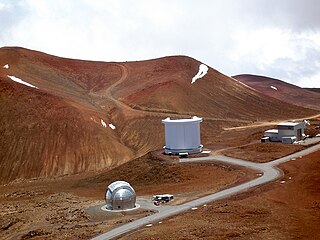
The James Clerk Maxwell Telescope (JCMT) is a submillimetre-wavelength radio telescope at Mauna Kea Observatory in Hawaii, US. The telescope is near the summit of Mauna Kea at 13,425 feet (4,092 m). Its primary mirror is 15 metres across: it is the largest single-dish telescope that operates in submillimetre wavelengths of the electromagnetic spectrum. Scientists use it to study the Solar System, interstellar dust and gas, and distant galaxies.

Robert Benjamin Leighton was a prominent American experimental physicist who spent his professional career at the California Institute of Technology (Caltech). His work over the years spanned solid state physics, cosmic ray physics, the beginnings of modern particle physics, solar physics, the planets, infrared astronomy, and millimeter- and submillimeter-wave astronomy. In the latter four fields, his pioneering work opened up entirely new areas of research that subsequently developed into vigorous scientific communities.
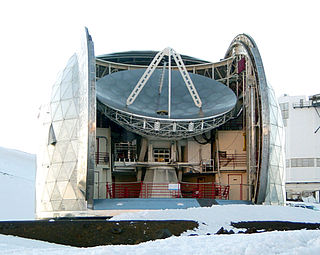
The Caltech Submillimeter Observatory (CSO) was a 10.4-meter (34 ft) diameter submillimeter wavelength telescope situated alongside the 15-meter (49 ft) James Clerk Maxwell Telescope (JCMT) at Mauna Kea Observatories. Beginning in 1986, it was engaged in submillimeter astronomy of the terahertz radiation band. The telescope closed on September 18, 2015.

The Submillimeter Array (SMA) consists of eight 6-meter (20 ft) diameter radio telescopes arranged as an interferometer for submillimeter wavelength observations. It is the first purpose-built submillimeter interferometer, constructed after successful interferometry experiments using the pre-existing 15-meter (49 ft) James Clerk Maxwell Telescope and 10.4-meter (34.1 ft) Caltech Submillimeter Observatory as an interferometer. All three of these observatories are located at Mauna Kea Observatory on Mauna Kea, Hawaii, and have been operated together as a ten element interferometer in the 230 and 345 GHz bands. The baseline lengths presently in use range from 16 to 508 meters. The radio frequencies accessible to this telescope range from 194–408 gigahertz (1.545–0.735 mm) which includes rotational transitions of dozens of molecular species as well as continuum emission from interstellar dust grains. Although the array is capable of operating both day and night, most of the observations take place at nighttime when the atmospheric phase stability is best.

Owens Valley Radio Observatory (OVRO) is a radio astronomy observatory located near Big Pine, California (US) in Owens Valley. It lies east of the Sierra Nevada, approximately 350 kilometers north of Los Angeles and 20 kilometers southeast of Bishop. It was established in 1956, and is owned and operated by the California Institute of Technology (Caltech). The Owens Valley Solar Array portion of the observatory has been operated by New Jersey Institute of Technology (NJIT) since 1997.
The Combined Array for Research in Millimeter-wave Astronomy (CARMA) was an astronomical instrument comprising 23 radio telescopes, dedicated in 2006. These telescopes formed an astronomical interferometer where all the signals are combined in a purpose-built computer to produce high-resolution astronomical images. The telescopes ceased operation in April 2015 and were relocated to the Owens Valley Radio Observatory for storage.

The Hat Creek Radio Observatory (HCRO) is operated by the SETI Institute in the Western United States. The observatory is home to the Allen Telescope Array and one of the three CHIME FRB outriggers, as well a number of other smaller telescopes and instruments.

Submillimetre astronomy or submillimeter astronomy is the branch of observational astronomy that is conducted at submillimetre wavelengths of the electromagnetic spectrum. Astronomers place the submillimetre waveband between the far-infrared and microwave wavebands, typically taken to be between a few hundred micrometres and a millimetre. It is still common in submillimetre astronomy to quote wavelengths in 'microns', the old name for micrometre.

Llano de Chajnantor Observatory is the name for a group of astronomical observatories located at an altitude of over 4,800 m (15,700 ft) in the Atacama Desert of northern Chile. The site is in the Antofagasta Region approximately 50 kilometres (31 mi) east of the town of San Pedro de Atacama. The exceptionally arid climate of the area is inhospitable to humans, but creates an excellent location for millimeter, submillimeter, and mid-infrared astronomy. This is because water vapour absorbs and attenuates submillimetre radiation. Llano de Chajnantor is home to the largest and most expensive astronomical telescope project in the world, the Atacama Large Millimeter Array (ALMA). Llano de Chajnantor and the surrounding area has been designated as the Chajnantor Science Reserve by the government of Chile.

An astronomical interferometer or telescope array is a set of separate telescopes, mirror segments, or radio telescope antennas that work together as a single telescope to provide higher resolution images of astronomical objects such as stars, nebulas and galaxies by means of interferometry. The advantage of this technique is that it can theoretically produce images with the angular resolution of a huge telescope with an aperture equal to the separation, called baseline, between the component telescopes. The main drawback is that it does not collect as much light as the complete instrument's mirror. Thus it is mainly useful for fine resolution of more luminous astronomical objects, such as close binary stars. Another drawback is that the maximum angular size of a detectable emission source is limited by the minimum gap between detectors in the collector array.
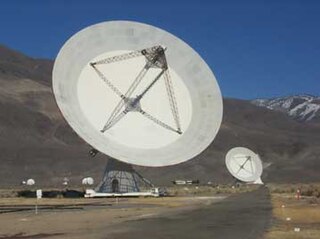
The Owens Valley Solar Array (OVSA), also known as Expanded Owens Valley Solar Array (EOVSA), is an astronomical radio telescope array, located at Owens Valley Radio Observatory (OVRO), near Big Pine, California, with main interests in studying the physics of the Sun. The instruments of the observatory are designed and employed specifically for studying the activities and phenomena of our solar system's sun. Other solar dedicated instruments operated on the site include the Solar Radio Burst Locator (SRBL), the FASR Subsystem Testbed (FST), and the Korean SRBL (KSRBL). The OVSA is operated by the New Jersey Institute of Technology (NJIT), which also operates the Big Bear Solar Observatory.
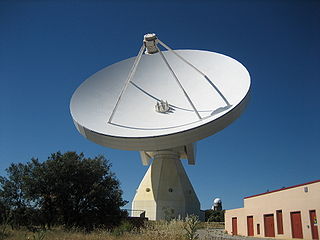
The Yebes Observatory RT40m, or ARIESXXI, is a radio telescope which is part of the observatory at Yebes, Spain. It is a 40-metre Cassegrain–Nasmyth telescope.

The OVRO 40 meter Telescope is a radio telescope at the Owens Valley Radio Observatory near Big Pine, California, US. It is owned and operated by Caltech. The telescope is easily visible from the section of US highway 395 just north of Big Pine.

The Large Latin American Millimeter Array (LLAMA) is a single-dish 12 m Nasmyth optics antenna which is under construction in the Puna de Atacama desert in the Province of Salta, Argentina, next to the Qubic experiment. The primary mirror accuracy will allow observation from 40 GHz up to 900 GHz. After installation it will be able to join other similar instruments to perform Very Large Base Line Interferometry or to work in standalone mode. Financial support is provided by the Argentinian and Brazilian governments. The total cost of construction, around US$20 million, and operation as well as the telescope time use will be shared equally by the two countries. Construction planning started in July 2014 after the formal signature of an agreement between the main institutions involved.
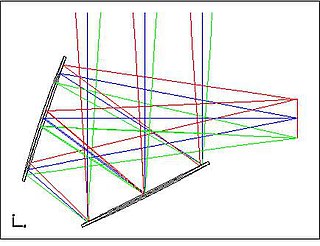
The Crossed Dragone Telescope is an off-axis telescope design consisting of a parabolic primary mirror and a large concave secondary mirror arranged so that the focal plane is at right angles to the incoming light. In this configuration the polarization of light is preserved through the optics.
Thomas Gould Phillips was a British-born physicist, who worked primarily in the United States. He was a pioneer in the field of submillimeter astronomy, who both developed new instrumentation and made ground-breaking observations. He oversaw the construction of, and was the first and longest-serving director of the Caltech Submillimeter Observatory.




